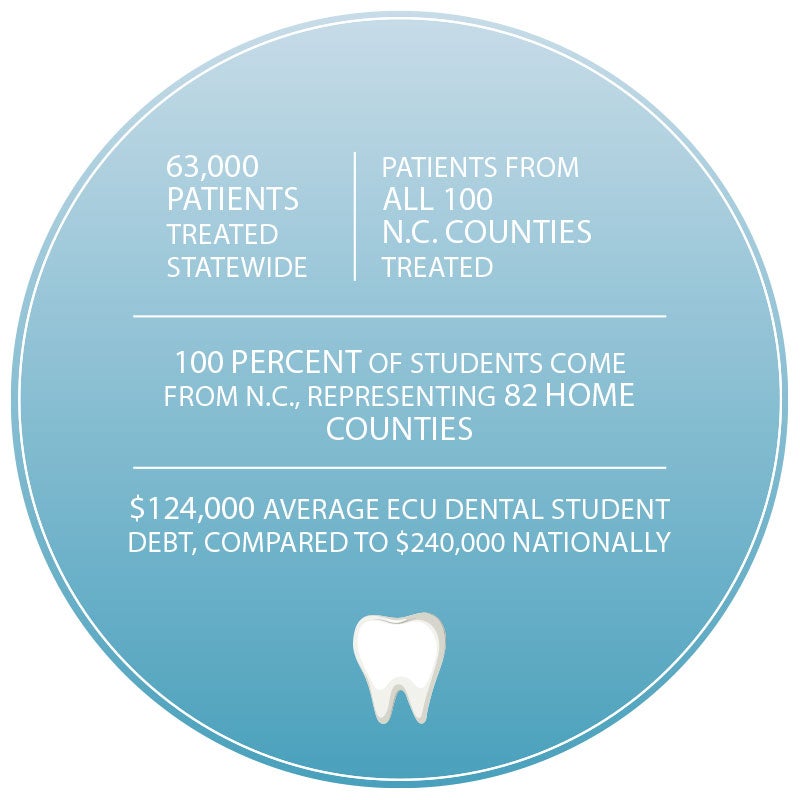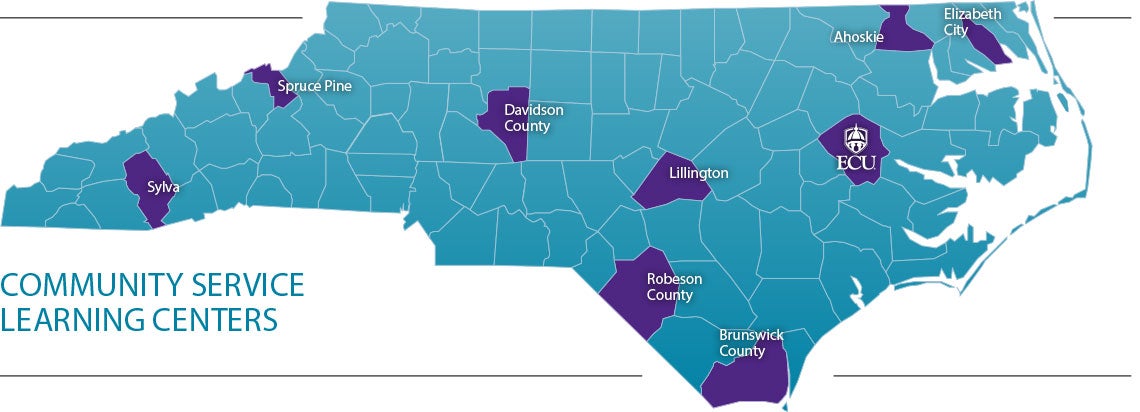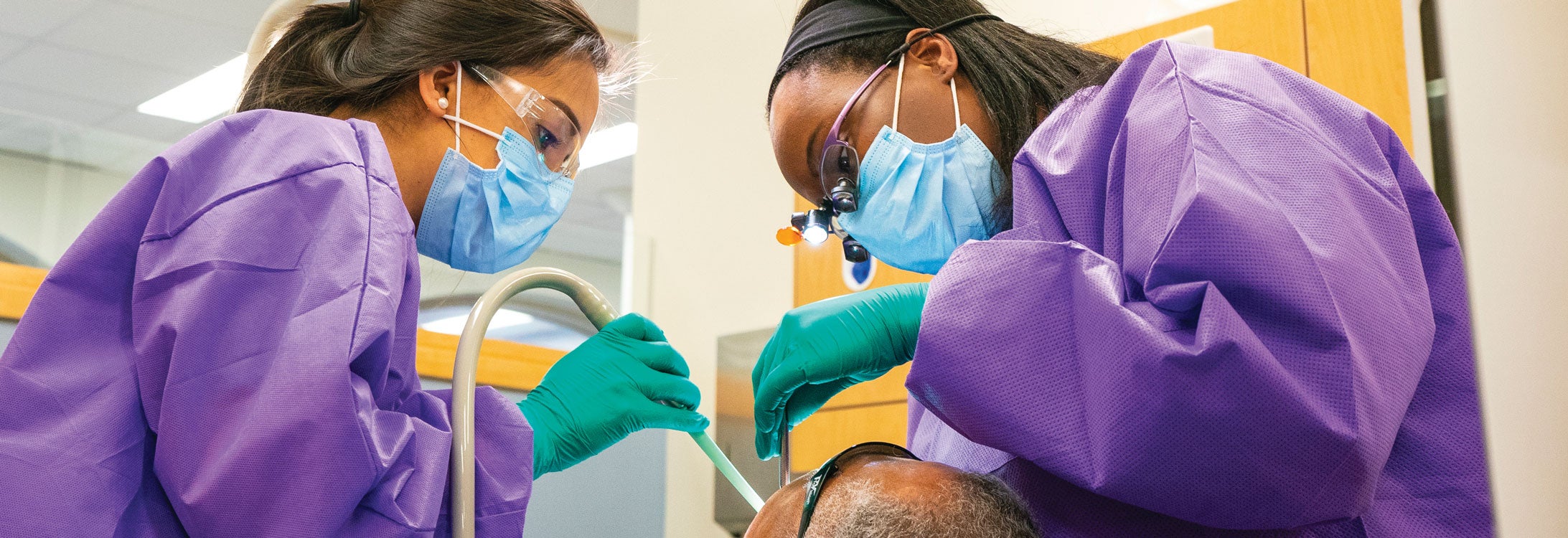A creative solution to creating smiles
ECU dental school and its statewide centers thrive on innovation

Fourth-year dental student Velvet McClurkin talks with patient Tommy Pearson after his appointment at the Ahoskie community service learning center.
A narrow ribbon of road winds for 60 miles northeast of Greenville, threading through cotton fields and horse pastures. The road leads to quintessential small-town Ahoskie — where an East Carolina University dental office uses a pioneering combination of creativity, innovation and technology for dentistry and education.
The ECU School of Dental Medicine’s community service learning center in Ahoskie — along with its seven statewide counterparts that stretch from the Appalachians to the Atlantic — is part of one of the most enterprising recent innovations to dental education and patient treatment. The CSLCs in rural and underserved communities provide students hands-on training while patients receive much-needed dental care.
Now preparing to graduate its fifth class of new dentists, the school has treated more than 63,000 patients who come from all 100 counties in the state. It is educating students who are all from North Carolina and call 82 of those counties home. Following this spring’s commencement, the school boasts around 250 alumni.
In March, the American Dental Education Association recognized the CSLC model by awarding it with a 2019 William J. Gies Award for Innovation, Vision and Achievement through its ADEAGies Foundation.
 From model to mission
From model to mission
Dental school supporters have long touted its ability to educate new dentists for a state that for years has experienced a dentist shortage, especially in the 80 rural North Carolina counties where 40 percent of the state’s population lives. Not only do its rigorously trained graduates fill the slots being vacated by rapidly retiring veteran dentists, they also address the gap in oral health care felt in most of North Carolina’s rural and underserved communities
“Our model focusing on rural communities and underserved populations fits perfectly into ECU’s mission of service,” said Dr. Greg Chadwick, dean. “Using a curriculum that combines rigorous coursework with a novel approach to service and clinical experiences, we are shaping not only dentists, but leaders who will explore new ways to improve oral health across North Carolina.”
The CSLCs have allowed the dental school to create modern solutions for the unique oral health care problems facing residents of North Carolina.
“The Gies Award is a wonderful reminder of our colleagues’ innovative work in dental education and how they are improving the lives of the individuals we are committed to serve,” said Dr. Richard W. Valachovic, president and CEO of ADEA, when the award was first announced last fall.
An answer for patients
Amber Doering of Como was tasked with finding affordable, convenient and top-quality dental care not only for her and her husband but also for her eight children. The Ahoskie CSLC proved a perfect fit for the family and helped break down the barriers to care they previously faced.
“This dental school truly met a need where there was a big gap,” Doering said. “I have also seen people firsthand who needed help, who lived in pain and were literally missing much-needed teeth out of lack of help or choices due to their budget constraints. Now they are smiling again because they received the help they needed.”
For ECU to produce service-minded dentists and take its students and faculty straight to the rural communities in the greatest need was an idea born of the entrepreneurial spirit that sparked the school.
“In the beginning, those leading the charge really had to think outside the box,” said Dr. Margaret Wilson, vice dean and associate dean for student affairs. “When they started thinking of the dental school, its curriculum and the CSLC model, they asked questions like, ‘Why couldn’t we do this?’ They just had a fresh perspective not hampered by traditional ideas that could box others in.”

Returning home
During their fourth year of dental school at ECU, students spend a total of 27 weeks learning and living in the CSLC communities during nine-week rotations. In traditional dental school clinics, students have more limited collaboration with other dental team members and usually see one patient during each clinic session. Students and residents at the ECU CSLCs typically see five to six patients a day and are exposed to the daily workings of a dental practice through interaction with dental assistants, hygienists and administrative staff.

“The school’s curriculum model front-loads our basic science and pre-clinical learning, providing students with more time for hands-on clinical training,” said third-year student Akeadra Bell.
Dr. Carol Anderson, faculty director of the Elizabeth City center, said the CSLC model urges students to consider every angle of a problem before choosing the best route for the patient.
“This model is really unique in that students can think beyond what’s right in front of them and come up with interesting treatment plans for patients,” Anderson said. “When students learn here, they’re able to think on their feet, assess urgent care quickly and deliver on that.”
Students also engage in research and projects that are geared toward solving long-term problems that will increase patient access and improve care.
“The student projects that are executed through the CSLCs focus on creativity to increase our patients’ access,” said Dr. Rob Tempel, associate dean for extramural clinical practices. “They bring solutions to topics from fee reduction and language barriers to transportation.”
The experience also offers students a complete perspective of what to expect after dental school.
Dr. Nicole Beasley ’16 grew up in Jackson and knew early on she wanted to be a dentist. After graduating from the School of Dental Medicine, she completed an advanced education in general dentistry residency at CSLC-Ahoskie. She then returned to Northampton County and works as the only dentist at Rural Health Group, a federally qualified health center that offers care to uninsured patients who meet government guidelines. She credits the dental school’s curriculum and model for teaching her to think more critically and service-minded.
“I always intended to come back to Jackson after dental school,” Beasley said, “but when it was time to start looking for jobs, I considered other locations. I made my decision by asking myself, ‘Where am I most needed?’ And the answer was, ‘At home.’”

Dr. Rob Tempel, associate dean for extramural clinical practices, finds videoconferencing an essential tool in working with faculty and staff at the eight community service learning centers across the state.
Funding program checks all boxes
Funds set up to benefit School of Dental Medicine patients in financial need are fulfilling a two-pronged mission across the state.
The patient care funds provide students essential experience in formulating treatment plans based on what the patient can afford and funding available through the PCF.
While each fund has its own donor-established criteria, many of the ECU School of Dental Medicine funds are based on a model that assesses not only the patient’s dental needs but also their ability to “partner” in paying for the assessment and care and the educational needs of students. Faculty direct the use of the patient care funds.
“Through these funds, our patients are great partners in our efforts to teach our students the essential skills they need to become the next generation of dental professionals,” said Mark Notestine, president of the ECU Medical & Health Sciences Foundation, which houses the patient care funds.
“Since we already provide dental services at reduced fees, this means that each dollar that is donated is stretched even further,” said Dr. Matt Causey, clinical assistant professor and chair of the PCF. “The funds cover procedures for patients in financial need, procedures that are of educational benefit to the students. This has a tremendous impact on the health of our patients.”
Said one patient who received PCF-funded care, “The difference in what the school and the patient care funds gave me and what it would cost me is basically the cost of food for a month.”
